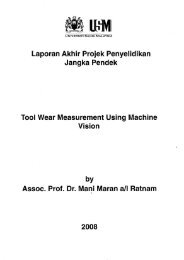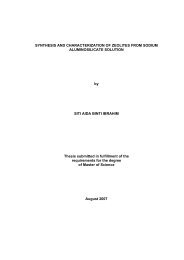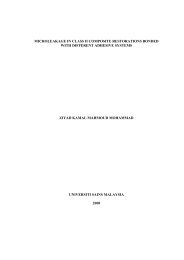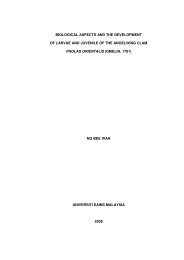design and development of a secure wireless ... - ePrints@USM
design and development of a secure wireless ... - ePrints@USM
design and development of a secure wireless ... - ePrints@USM
Create successful ePaper yourself
Turn your PDF publications into a flip-book with our unique Google optimized e-Paper software.
The advantage <strong>of</strong> a frequency hopping signal is that it is relatively jam <strong>and</strong><br />
intercept resistant. This feature is used widely in military communications where<br />
the risk <strong>of</strong> either enemy jamming or intercept is great. It is also used in the<br />
mobile communication industry as a multiple access technique where systems<br />
are required to h<strong>and</strong>le high capacity data reliably in an urban setting<br />
(Hedylamarr, 2001). Frequency hopping (FH) communication systems have<br />
become an important component <strong>of</strong> military communications strategy. FH<br />
systems <strong>of</strong>fer an improvement in performance when the communication system<br />
is attacked by hostile interference. FH systems also reduce the ability <strong>of</strong> a<br />
hostile observer to receive <strong>and</strong> demodulate the communications signal. FH<br />
systems are susceptible to a number <strong>of</strong> jamming threats, such as noise<br />
jammers <strong>and</strong> narrowb<strong>and</strong>, single or multitone jammers.<br />
If all frequency hops are to be jammed, the jammer has to divide its power over<br />
the entire hop b<strong>and</strong>, thus lowering the amount <strong>of</strong> received jamming power at<br />
each hop frequency. Unfortunately, if the tone jamming signal has a significant<br />
power advantage, reliable communications will not be possible (Katsoulis <strong>and</strong><br />
Robertson, 1997). Even when the jamming tones experience fading, reliable<br />
communications are not possible when the jamming signal has a significant<br />
power advantage (Robertson <strong>and</strong> Sheltry, 1996). If the FH signal has a<br />
sufficient hop range, received jamming power will be negligible. If a tone jammer<br />
is focused on a particular portion <strong>of</strong> the FH b<strong>and</strong>width, its power may adversely<br />
impact communications. A possible antijamming strategy is use a narrow<br />
b<strong>and</strong>stop filter to remove the tone from the received signal spectrum. Pérez et<br />
al. (2002) described a method for filtering tone jammers from a frequency<br />
7

















